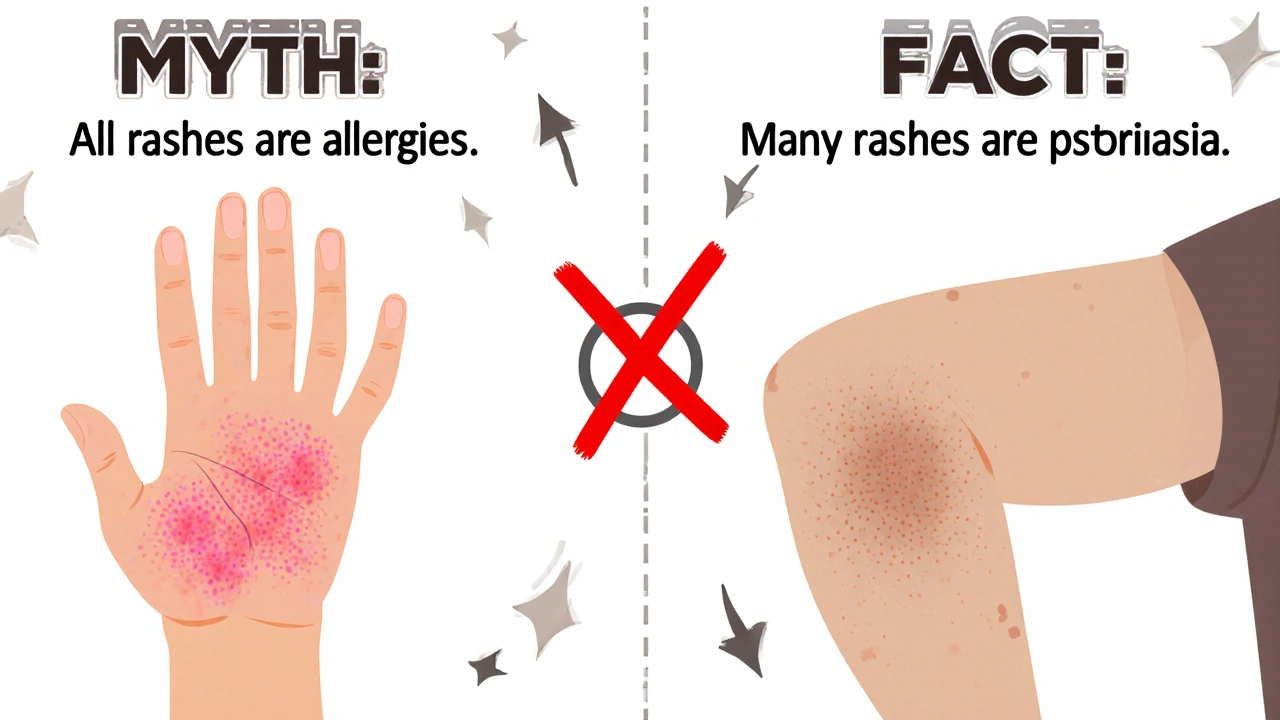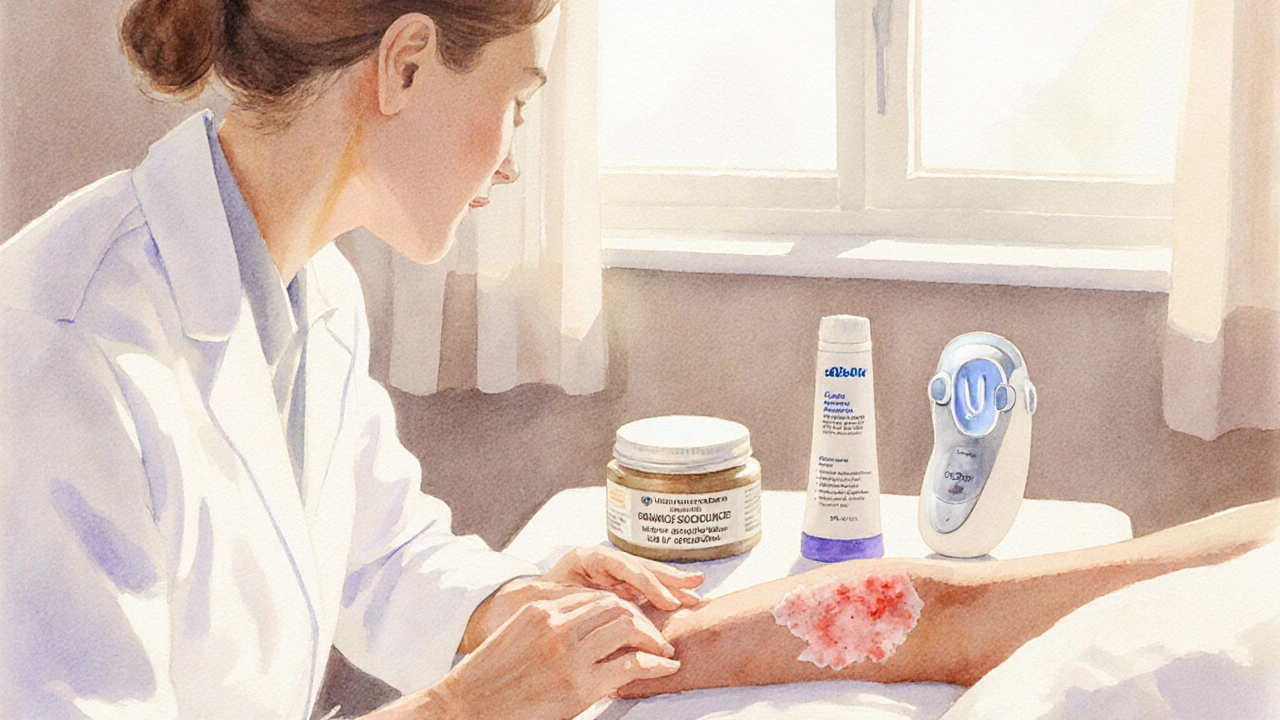Skin Inflammation Myths Busted: What’s True About Rashes, Eczema, and More
 Oct, 10 2025
Oct, 10 2025
Skin Inflammation Condition Checker
Possible Conditions Identified:
Dermatitis
Red patches, itching, sometimes blisters. Often caused by contact with irritants like soaps or metals.
Eczema
Dry, scaly patches, intense itch, chronic course. Linked to genetic predisposition and environmental factors.
Psoriasis
Silvery plaques, thickened skin, sometimes joint pain. Caused by immune dysfunction and trauma.
Rosacea
Facial redness, visible vessels, occasional bumps. Triggered by heat, spicy foods, and certain microbes.
When your skin looks red, itchy, or scaly, the first thing that flashes through most minds is a flood of myths - “It’s just an allergy,” “A home remedy will fix it,” or “If it hurts, it’s not serious.” skin inflammation is a real, complex response that can signal anything from a harmless irritation to an underlying disease. This guide separates fact from fiction, explains the biology in plain language, and gives you a practical checklist to decide when to treat at home and when to call a professional.
Key Takeaways
- Skin inflammation is the body’s immune response to injury, infection, or irritation.
- Not all rashes are allergies; many are forms of dermatitis, eczema, psoriasis, or rosacea.
- Over‑the‑counter creams help some conditions but can worsen others.
- Natural remedies can be soothing but aren’t automatically safe or effective.
- Seek medical advice if the inflammation spreads, is painful, or lasts longer than two weeks.
What Is Skin Inflammation?
Skin inflammation is a physiological reaction of the skin’s immune system to a perceived threat such as trauma, infection, chemicals, or an autoimmune trigger. The process involves swelling, redness, heat, and often itching or pain as blood vessels dilate and immune cells release signaling molecules.
Common Types and Their Real Traits
Skin inflammation isn’t a one‑size‑fits‑all label. Below is a quick look at the most common forms, their typical triggers, and evidence‑based treatments.
| Condition | Typical Symptoms | Common Triggers | First‑Line Treatment |
|---|---|---|---|
| Dermatitis | Red patches, itching, sometimes blisters | Contact with irritants, soaps, metals | Barrier creams, avoidance, low‑potency steroids |
| Eczema (Atopic Dermatitis) | Dry, scaly patches, intense itch, chronic course | Genetic predisposition, allergens, stress | Moisturizers, prescription topical steroids, dupilumab for severe cases |
| Psoriasis | Silvery plaques, thickened skin, sometimes joint pain | Immune dysfunction, infection, trauma (Koebner phenomenon) | Vitamin D analogues, biologics, phototherapy |
| Rosacea | Facial redness, visible vessels, occasional bumps | Heat, spicy foods, alcohol, certain microbes | Metronidazole, azelaic acid, laser therapy |
Myth #1: All Rashes Are Allergic Reactions
It’s easy to assume a red, itchy spot means you’re allergic to something you touched. In reality, many rashes stem from intrinsic skin conditions like eczema or psoriasis, not an external allergen. For example, eczema can flare up after a night of dry air without any new soap or detergent.

Myth #2: “Itching Means It’s Not Serious”
People often think itching is a harmless nuisance, but intense itch can signal a deeper immune response. When histamine and other mediators like cytokines surge, they can also cause swelling and tissue damage. Persistent itch that disrupts sleep or leads to skin breaks warrants a medical review.
Myth #3: Over‑the‑Counter Creams Cure Everything
OTC hydrocortisone or menthol creams are great for minor irritations, but they won’t fix chronic conditions. Applying a strong steroid to infected skin can mask symptoms while the infection spreads. Conversely, using a fragrance‑free moisturizer on a fungal rash can feed the fungus, prolonging the problem.
Myth #4: Natural Remedies Are Always Safe
“Aloe gel will soothe any rash” sounds comforting, yet natural doesn’t equal risk‑free. Essential oils, for instance, can contain allergens that worsen dermatitis. Some herbal extracts may interfere with prescription topical steroids, reducing their efficacy. Always patch‑test a small area and consult a clinician before regular use.
Myth #5: Sun Exposure Cures Inflammation
While controlled UV light can help psoriasis, indiscriminate sunbathing often aggravates rosacea and can trigger photo‑allergic reactions. UV radiation also damages the skin barrier, leading to increased water loss and more irritation in eczema‑prone individuals.

How to Spot Real Problems Early
- Redness that spreads rapidly or is accompanied by fever.
- Painful swelling, pus, or crusted lesions.
- Inflammation lasting more than 14days without improvement.
- Repeated flares in the same area despite proper self‑care.
- Associated symptoms such as joint pain (possible psoriatic arthritis).
If you tick any of these boxes, it’s time to book an appointment.
Effective Treatment Options (What Works and Why)
Below is a quick cheat‑sheet of proven approaches, grouped by severity.
- Barrier Repair: Use fragrance‑free moisturizers containing ceramides, glycerin, or hyaluronic acid to restore the skin’s protective layer.
- Topical Steroids: Low‑potency steroids (e.g., 1% hydrocortisone) for short‑term flare control; higher potency for physician‑guided use.
- Calcineurin Inhibitors: Tacrolimus or pimecrolimus for sensitive areas (face, eyelids) where steroids risk thinning.
- Systemic Medications: Oral antihistamines for itch, doxycycline for rosacea, or biologics (e.g., secukinumab) for severe psoriasis.
- Phototherapy: Narrow‑band UVB for persistent eczema or psoriasis when topical regimens fall short.
- Lifestyle Adjustments: Lukewarm showers, breathable fabrics, and stress‑reduction techniques (mindfulness, regular exercise).
When to See a Professional
Even with the best at‑home routine, some signals demand expert care:
- Rapid spreading of redness or swelling.
- Signs of infection-yellow crusts, warmth, fever.
- Persistent itching that leads to skin cracks.
- Unclear diagnosis after two weeks of self‑treatment.
- Impact on daily life-sleep loss, work absence, emotional distress.
Dermatologists can perform skin biopsies, prescribe targeted biologics, and guide long‑term management plans.
Frequently Asked Questions
Can stress really make my skin inflamed?
Yes. Stress releases cortisol and other hormones that can disrupt the skin barrier and increase cytokine activity, worsening conditions like eczema and psoriasis.
Is it safe to use a steroid cream on a fungal rash?
No. Steroids suppress local immunity, giving fungi a chance to thrive. Antifungal treatment should be used first.
How long should I wait before seeing a doctor for a new rash?
If the rash doesn’t improve after 5‑7days of proper home care, or if you notice pain, swelling, or fever, schedule a visit promptly.
Do moisturizers actually prevent flare‑ups?
Consistently using a barrier‑repair moisturizer helps retain moisture, reduces transepidermal water loss, and can lower the frequency of eczema flare‑ups.
Is there a quick test to know if my rash is allergic?
Patch testing performed by a dermatologist is the gold standard. Home “scratch tests” are unreliable and can worsen the rash.
jake cole
October 10, 2025 AT 20:10Wow, this article drags on like a never‑ending medical textbook while pretending to be a quick cheat‑sheet. Skip the fluff and stick to proven steroids for real relief.
Natalie Goldswain
October 16, 2025 AT 09:39i get u but honestly the guide does have some good points like using ceramide moisturizers.
khajohnsak Mankit
October 21, 2025 AT 23:08Reading through that myth‑busting piece feels like embarking on an expedition across a kaleidoscopic landscape of dermatological intricacies. Each paragraph unfurls like a tapestry woven from the threads of immunology, genetics, and environmental whispers. The author wisely distinguishes between the superficial allure of “just an allergy” and the deeper undercurrents of atopic eczema, where barrier dysfunction reigns supreme. They illuminate how cytokine storms can manifest as the relentless itch that haunts sleepless nights, a phenomenon that is far from trivial. The discussion of psoriasis as more than skin deep, highlighting its potential alliance with joint inflammation, adds a layer of gravitas often omitted in popular health blogs. Moreover, the spotlight on rosacea’s mischievous triggers-spicy cuisine, heated rooms, and microbial mischief-serves as a reminder that even facial redness can be a complex dialogue between blood vessels and microbes. The section on natural remedies is refreshingly cautionary, warning that “herbal” does not automatically equate to harmless, a nuance many influencers overlook. By championing barrier‑repair moisturizers rich in ceramides, the guide offers a tangible, evidence‑based strategy that readers can implement immediately. The recommendation of low‑potency steroids for short‑term flare‑ups, juxtaposed with the warning against their misuse on infected skin, demonstrates a balanced clinical perspective. I also appreciate the inclusion of phototherapy as a viable option for recalcitrant eczema, a treatment often relegated to specialist discussions. The checklist for red‑flag symptoms-spreading redness, fever, painful swelling-acts as a practical triage tool that could potentially avert severe complications. While the article’s tone remains accessible, it never condescends, preserving scientific integrity without drowning the layperson in jargon. The embedded interactive tool, though simple, empowers users to correlate symptoms with possible conditions, fostering a sense of agency. In sum, this guide transcends the typical quick‑fix narrative, offering depth, nuance, and actionable advice that respects both the skin’s biology and the reader’s curiosity.
Jayant Paliwal
October 27, 2025 AT 12:37Indeed; the author’s exposition traverses a myriad of dermatological paradigms; however, certain assertions warrant scrutiny-for instance, the blanket endorsement of ceramide‑laden moisturizers without acknowledging individual lipid profile variations; additionally, the claim that phototherapy is universally beneficial overlooks contraindications such as photosensitivity disorders; still, the piece commendably balances scientific rigor with layman accessibility.
Kamal ALGhafri
November 2, 2025 AT 02:05While the points are noted, the article does provide evidence‑based references supporting its recommendations.
Gulam Ahmed Khan
November 7, 2025 AT 15:34Great job breaking down the myths! 😊 It’s super helpful to know when a simple moisturizer will do the trick and when it’s time to see a dermatologist.
John and Maria Cristina Varano
November 13, 2025 AT 05:03i dont kno why ppl think all this is new, same old info just dressed up.
Melissa Trebouhansingh
November 18, 2025 AT 18:31One cannot help but marvel at the sheer breadth of interdisciplinary synthesis presented herein; the author deftly interlaces immunopathogenesis with pragmatic therapeutic algorithms, thereby elevating the discourse beyond mere layperson pamphleteering. Such erudition invites the discerning reader to contemplate the nuanced interplay between cutaneous barrier integrity and systemic inflammatory cascades, a perspective seldom afforded by quotidian health blogs.
Stan Oud
November 24, 2025 AT 08:00Honestly, the article overcomplicates something that could be summed up in a couple of bullet points.
Ryan Moodley
November 29, 2025 AT 21:29Oh, the audacity of simplifying complex immunological phenomena into “bullet points”! It’s an insult to both science and the suffering of those battling chronic skin conditions.
Derek Dodge
December 5, 2025 AT 10:58looks like a solid overview, though i wish there were more pics of actual rashes.